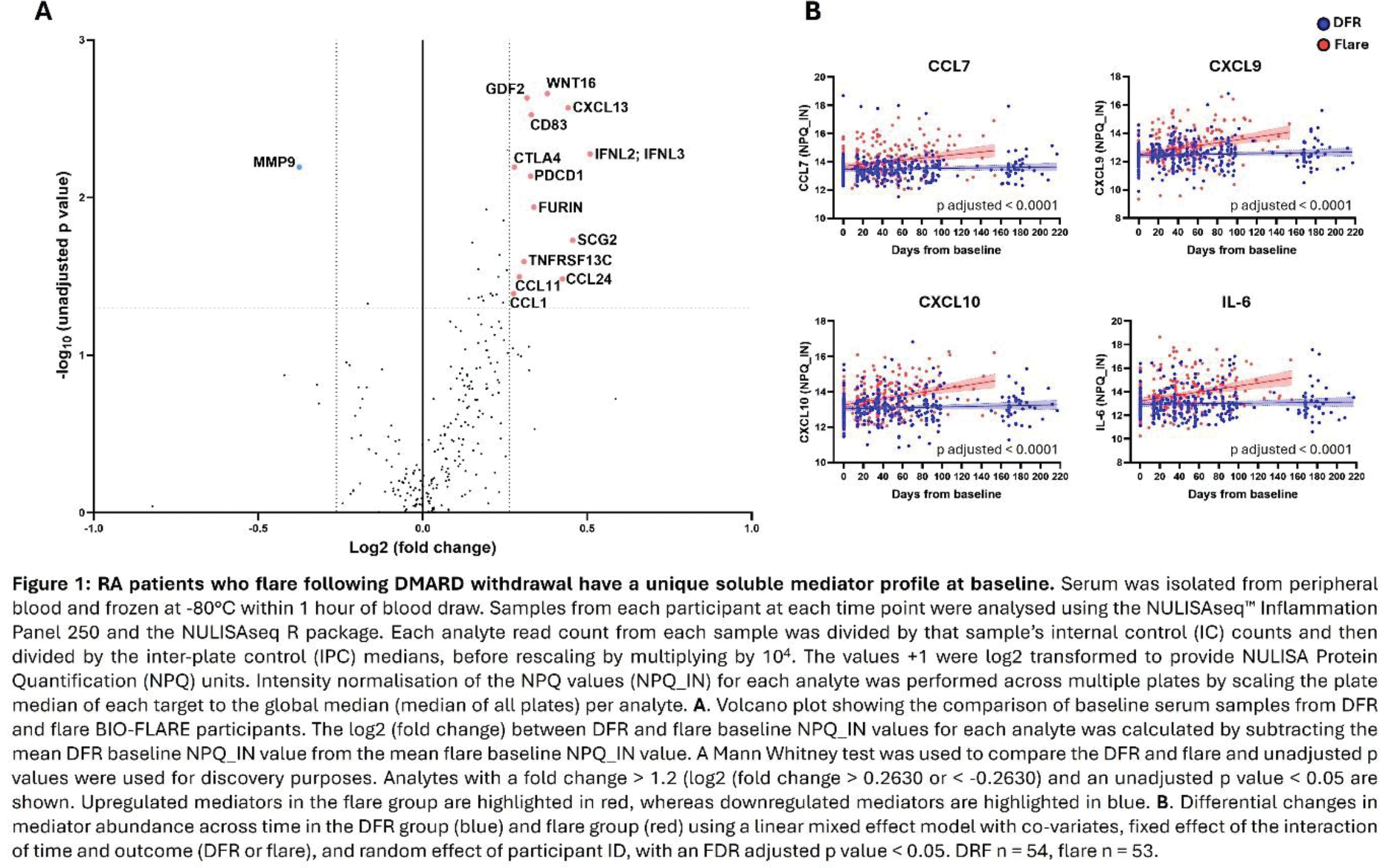

Background: Little is known of the factors that trigger disease relapses/flares in patients with rheumatoid arthritis (RA). These mechanisms have been difficult to study due to the unpredictable nature of flare. The BIOlogical Factors that Limit sustAined Remission in rhEumatoid arthritis (BIO-FLARE) study [1] is an experimental medicine study of ‘synchronised’ RA flares in which treatment is withdrawn in RA patients in clinical remission receiving conventional synthetic (cs)DMARDs. Subsequently, approximately 50% flare within 6 months, the remainder maintaining drug-free remission (DFR).
Objectives: We have assessed, longitudinally, circulating T cell subsets and mediators following treatment cessation, to better under the mechanisms driving flare and maintaining DFR.
Methods: Individuals with RA receiving methotrexate, sulfasalazine and hydroxychloroquine, singly or in combinations, in clinician-defined remission with a DAS28-CRP <2.4 were recruited into BIO-FLARE. Treatment was stopped and participants monitored over 24 weeks, with serum and Smart Tube-fixed peripheral blood stored at 0, 2, 5, 8, 12 and 24 weeks. Flare was defined as DAS28-CRP ≥3.2 at any study visit, or DAS28-CRP ≥2.4 on two occasions within a 14-day period. Soluble serum mediators were detected by the NULISAseq Inflammation Panel 250 (Alamar Biosciences) [2]. Following data normalisation and quality control, differential expression analysis was performed comparing flare and DFR at baselines, as well as longitudinal analysis. Circulating T cell subsets were assessed using a 16 marker Phosflow panel.
Results: At baseline, participants who subsequently flared and those who maintained DFR were well matched clinically, except for RF/ACPA titres, which were higher in those who subsequently flared. In contrast, NULISAseq analysis revealed differences in a number of inflammatory mediators, such as CXCL13 and soluble PD-1 (PDCD1), and immunoregulatory molecules, such as soluble CD83 and CTLA-4, all of which were elevated in the flare group at baseline (Figure 1A). When assessing changes in soluble mediators across time from the point of DMARD withdrawal, few changes were detected in the DFR group, whereas a number of inflammatory mediators, such as CCL7, CXCL9, CXCL10, and IL-6, increased in the flare group (Figure 1B). Flow cytometry analysis at baseline revealed an increase in the proportion of naive CD4+ T cells expressing phosphorylated STAT3 (pSTAT3) in the flare group (Figure 2A), which correlated with baseline levels of IL-6 (Figure 2B). In addition, there was an increase in the proportion of CD4+CD25high Tregs in the DFR group at baseline (Figure 2C), and, following DMARD withdrawal, Tregs increased in the flare group from baseline (Figure 2D). Interestingly, expression of pSTAT3 in Tregs increased over time in the flare group only (Figure 2E) and correlated with IL-6 and LIF levels (Figure 2F).
Conclusion: Even prior to DMARD cessation, individuals who subsequently flare following csDMARD withdrawal display a unique soluble proteome, indicative of immune activation and regulation. Other mediators increase towards the point of flare, providing potential insights into flare physiology. At baseline there are elevated proportions of naive CD4+ T cells expressing IL-6-induced pSTAT3 in patients who subsequently flare, which mirrors early RA [3], and may contribute to dysregulation of these effector cells [4]. In addition, patients who achieve DFR have increased baseline Treg proportions and, whilst Treg proportions increase after DMARD withdrawal in both groups, those who flare have increased pSTAT3 expression in this subset, possibly driven by elevated circulating IL-6 and LIF. As pSTAT3 expression is suggested to impair Treg function [5], the Tregs expanded during flare may be dysfunctional due to their exposure to IL-6 and other pro-inflammatory cytokines. This work highlights key pathways involved in disease flare that warrant further investigation. Our ultimate goal is to develop biomarkers that will facilitate targeted treatment withdrawal in patients in remission, and to generate knowledge that may aid relapse prevention by appropriately targeted therapeutics.
REFERENCES: [1] Rayner F et al. BMC Rheumatol. 2021.
[2] Feng W et al. Nat Commun. 2023.
[3] Anderson et al. Ann Rheum Dis. 2016.
[4] Ridgley L et al. Front Immunol. 2019.
[5] Yang L et al. J Dermatol Sci. 2016.


Acknowledgements: NIL.
Disclosure of Interests: Amy E. Anderson: None declared , Fiona Rayner: None declared , Jessica Swift: None declared , Daniel Maunder: None declared , Henrique Lemos: None declared , David J Swan: None declared , Luke Jones: None declared , Graham Smith: None declared , Abbie Degnan: None declared , Imogen Wilson: None declared , Julie Diboll: None declared , Gary Reynolds: None declared , Jasmine Sim: None declared , Andrew Melville: None declared , Stefan Siebert AbbVie, Amgen, AstraZeneca, Janssen, Novartis, Pfizer, Syncona, Teijin Pharma and UCB, BMS, Boehringer-Ingelheim, Eli Lilly, GSK, Janssen and UCB, Iain B. McInnes: None declared , Carl S Goodyear: None declared , Catharien Hilkens: None declared , Karim Raza: None declared , Christopher D Buckley: None declared , Kenneth F Baker Modern Biosciences, Pfizer and Genentech, Arthur Pratt: None declared , Andrew Filer: None declared , John D Isaacs: None declared .
© The Authors 202. This abstract is an open access article published in Annals of Rheumatic Diseases under the CC BY-NC-ND license (